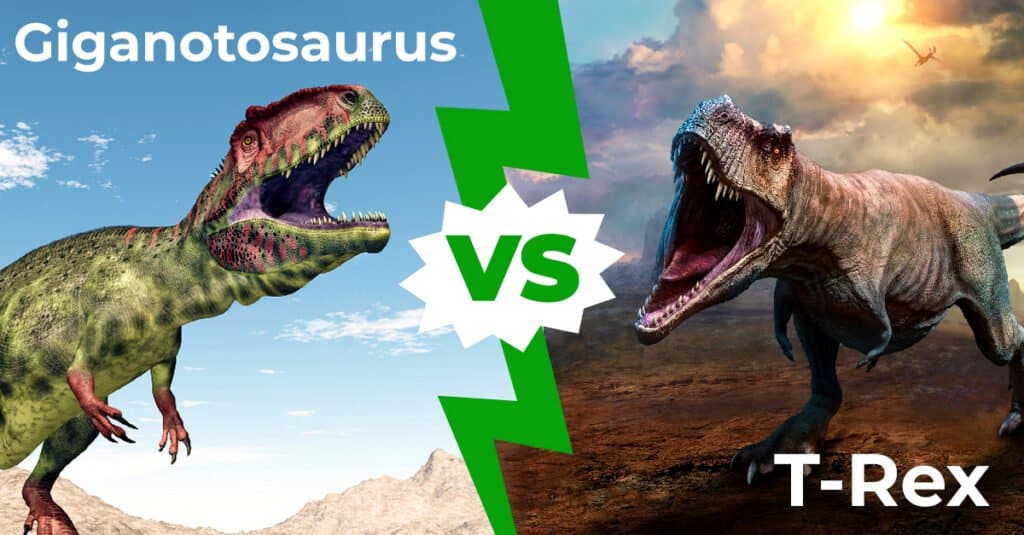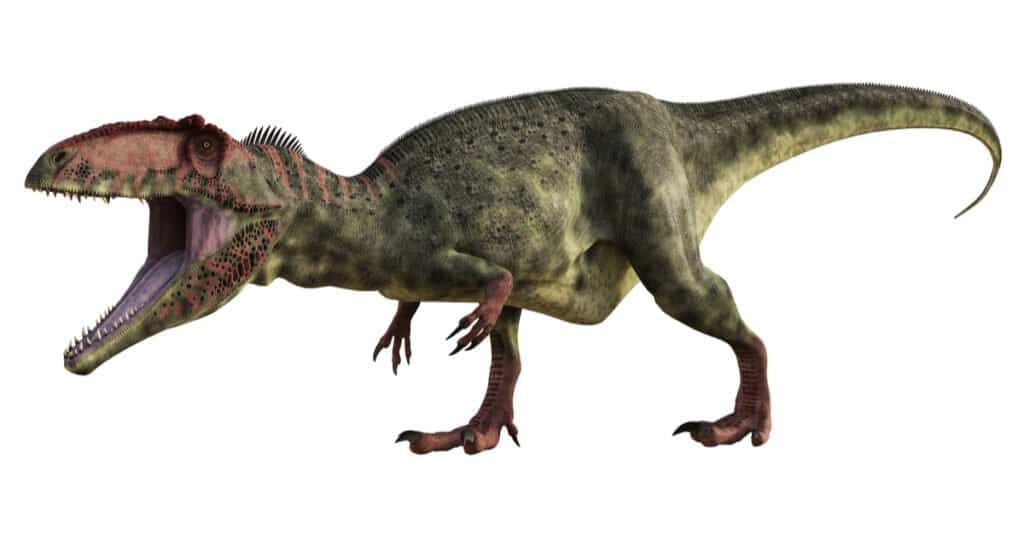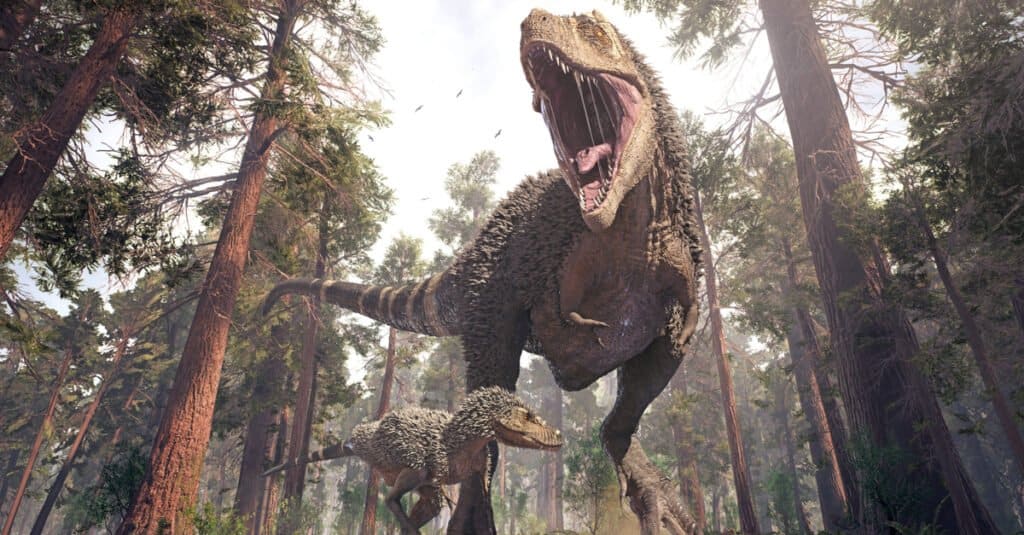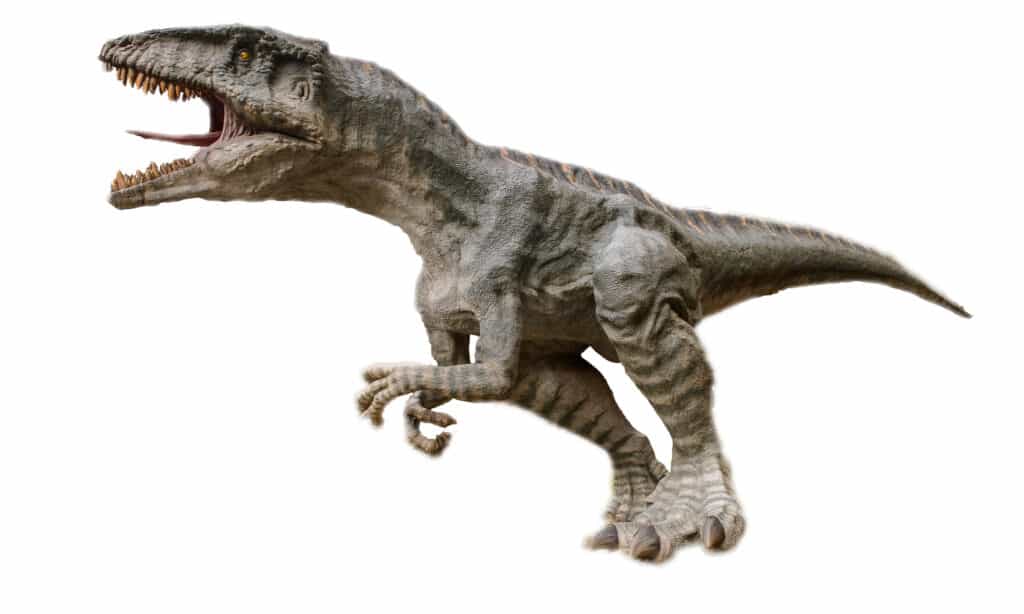A Giganotosaurus vs T-Rex fight would pit two of the most dangerous creatures to ever exist against each other.
Unfortunately, they missed each other’s presence by about 10 million years, with the Giganotosaurus going extinct 93 million years ago and the T-Rex living a maximum of 83 million years in the past.
That doesn’t mean we can’t take some statistics and figure out how this battle between massive dinosaurs would pan out.
We’re using the best information possible to determine which of these monstrous creatures would win if they were forced to fight.
Comparing a Giganotosaurus and T-Rex

| Giganotosaurus | T-Rex | |
| Size | Weight: 8,400 -17,600lbs Height: 12-20ft Length 45ft | Weight: 11,000-15,000lbs Height: 12-20ft Length: 40ft |
| Speed and Movement Type | 31 mph – Bipedal striding | 17 mph -Bipedal striding |
| Bite Power and Teeth | -6,000 N bite power -76 flat, serrated teeth – 8-inch teeth | – 35,000-64,000 Newtons bite force – 50-60 D-shaped serrated teeth – 12-inch teeth |
| Senses | – Great sense of smell – Very good vision, but less defined than T-Rex | – A very strong sense of smell – High sense of vision with very large eyes – Great hearing |
| Defenses | – Large size – Running speed | – Massive size – Running speed |
| Offensive Capabilities | – Sickle-shaped claws on short, powerful arms – Sharp feet claws – Long, serrated teeth -Ramming enemies | – Bone-crushing bites – Powerful neck for grabbing and thrashing enemies – Speed to chase down enemies – Ramming |
| Predatory Behavior | – Likely would attack large prey with claws and wait for them to bleed | – Possibly a devastating predator that could kill smaller creatures with ease – Potentially a scavenger |
The 7 Key Factors in a Fight Between Giganotosaurus and T-Rex

Giganotosaurus vs T-Rex would be decided by size, hunting capability, and intelligence.
©Orla/Shutterstock.com
The fight between a Giganotosaurus and a Tyrannosaurus Rex would be a brutal affair, but it would come down to several factors that give one creature the edge over the other.
We have distilled the data into seven fine points that would determine which creature would win in a fight.
Physical Features

T-rex’s upper jaw was shaped like a U, which helped them rip out more meat with each bite.
©iStock.com/Orla
Many hypothetical battles are over before they begin due to differences in the size, speed, intelligence, and strength of the fighters. Consider the following physical features and the way that they would affect a fight between these two dinosaurs.
Giganotosaurus is thought to have been one of the largest theropod dinosaurs. However, the incompleteness of its remains has made it hard to estimate its true size and reliably. It is impossible to determine with absolute certainty whether it was larger than the T-Rex or smaller. Different size estimates have been researched over time-based on different methods and depending on how many pieces are actually missing, but a full replica is not widely available.
Giganotosaurus vs T-Rex: Size

Giganotosaurus was one of the largest predators to ever roam the Earth.
©Herschel Hoffmeyer/Shutterstock.com
Although most people think the T-Rex was always the biggest creature to roam the planet, a few bigger dinosaurs existed. The Giganotosaurus weighed about 17,600 pounds, stood 20 feet high, and was about 45 feet long.
The T-Rex maxed out the scale at 15,000 pounds but was also 20 feet tall and 40 feet in length.
The comparison is close, but the Giganotosaurus is the bigger beast and has an advantage.
Giganotosaurus vs T-Rex: Speed and Movement
The T-Rex was a massive, thick dinosaur with powerful leg muscles, but it could only run at about 17 mph. It would run on its two legs, a large, stomping stride.
The Giganotosaurus was certainly faster, cruising along at 31 mph at a full sprint using a similar form of locomotion to the T-Rex, but one that was less constrained by bulky leg muscles.
Giganotosaurus is faster than the T-Rex and gets the advantage here.
Giganotosaurus vs T-Rex: Bite Power and Teeth
The T-Rex is simply indomitable in terms of bite power and teeth. Its jaws allowed for 35,000 Newtons and higher for bite strength. That would drive all 50-60 of their 8-12-inch teeth into an enemy, breaking bones and causing immense trauma.
Giganotosaurus had a much weaker bite of just 6,000 Newtons, but it had 76 sharp, serrated teeth ready to harm an enemy.
The T-Rex has the advantage in terms of bite force and teeth, and it’s not even close.
Giganotosaurus vs T-Rex: Senses
Tyrannosaurus Rex was an incredibly smart dinosaur with impeccable senses of smell, hearing, and sight. The Giganotosaurus was similar in some respects, having good smell and sight, but the information about their senses is underdeveloped.
The T-Rex gets the advantage here, partly because of how great its senses are known to be but also because we just don’t have enough information about the Giganotosaurus to say otherwise.
Giganotosaurus vs T-Rex: Physical Defenses
The very fast speed of the Giganotosaurus is probably its best defense along with its massive weight. It’s hard for enemies to successfully attack something so large.
The T-Rex shares the same benefits of a large body and the ability to outpace many smaller predators.
Since the Giganotosaurus is larger, this dinosaur gets the edge.

Tyrannosaurus Rex likely rammed its predators to the ground before biting them.
©Herschel Hoffmeyer/Shutterstock.com
Combat Skills
Having a strong defense is great, but the best defense is a good offense. Let’s see how the two dinosaurs measure up against each other in terms of combat.
Giganotosaurus vs T-Rex: Offensive Capabilities
The offensive powers of a Giganotosaurus are hard to measure because we don’t know exactly how they used their arms. It seems likely that they would use the large claws to harm enemies and then run away before resuming the attack. That’s a great technique. It could also bite and tear at foes with its strong teeth.
The T-Rex mostly fought using its massive bite power. However, it probably also rammed other enemies to the ground before finishing them.
Both techniques are fantastic, but going against each other, the T-Rex has the edge.
Giganotosaurus vs T-Rex: Predatory Behaviors
Both the T-Rex and Giganotosaurus were likely very direct in their hunting patterns. They’re too large to be stealthy, and they’re apex predators. The rest of the world was their buffet in their lifetimes.
Since both dinosaurs would likely charge to and kill their prey, this segment is a tie.
What Are Key Differences Between Giganotosaurus and T-Rex?
The Giganotosaurus was as tall as a T-Rex at 20 feet high, but it was also heavier, longer, and faster. Aside from their physical build, the most significant difference between them is their intelligence. The T-Rex was smarter than a Giganotosaurus and had more finely tuned senses.
Both were carnivores that were highly effective at using their large bodies and teeth to kill their prey. These two dinosaurs are alike in many ways, but their differences will be the deciding factor in the fight.
Who Would Win in a Fight Between Giganotosaurus and T-Rex?

Both Gianotosaurus and Tyrannosauru Rex were apex predators.
©Elenarts/Shutterstock.com
In a fight between Giganotosaurus and T-Rex, the Tyrannosaurus would win. The two dinosaurs are pretty similar to one another, but their approaches to fighting would make a world of difference.
A battle between Giganotosaurus and T-Rex would feature no stealth. This fight would be a heavyweight brawl with the Giganotosaurus at a severe disadvantage because it has to get way too close to the T-Rex to inflict damage.
Researchers believe Giganotosaurus fought by using its claws to bleed an enemy, and that is a good solution against similarly powered dinosaurs. When this dinosaur goes in for a deep cut, though, it will probably get killed.
The T-Rex would use its powerful leg muscles to help it ram and push the Giganotosaurus over before going in for a devastating bite that breaks bones, shatters a skull, or completely disables the dinosaur.
Even if the Giganotosaurus did come in and land a few attacks, the T-Rex is stocky and swift, able to turn and deliver a much more powerful counter for every attack the Giganotosaurus lands.
Whether it dies instantly or uses a burst of adrenaline to run before going down, the Giganotosaurus dies in this scenario.
Where Did They Live?
T-Rex lived in what is now North America and parts of Asia during the late Cretaceous period, about 68 to 66 million years ago. It was one of the last non-avian dinosaurs to exist before the mass extinction event that marked the end of the dinosaur era. Fossil evidence suggests T-Rex roamed an area stretching from present-day Canada through much of the western United States, as well as portions of Mexico, Mongolia, and China.
In comparison, Giganotosaurus was a slightly larger carnivore living in South America during roughly the same time frame as T-Rex, 97–89 million years ago. Its fossils have been found primarily in Argentina, though some remains have been discovered in neighboring countries such as Brazil and Chile.

T-Rex lived 60 million years ago in the western USA.
©Herschel Hoffmeyer/Shutterstock.com
Lifespan
Tyrannosaurus rex was one of the largest carnivorous dinosaurs to have ever lived. Adults typically weighed more than 10,000 pounds and reached sexual maturity at around 20 years old. T-Rex had a relatively long lifespan for a dinosaur, living up to 28 years in some cases. This extended life span likely allowed T-Rex to gain experience and strength over time, allowing them to become far superior hunters than their shorter-lived counterparts.
Giganotosaurus had an unknown growth rate due to a lack of juvenile and subadult specimens. However, if we assume it has similar lifespan characteristics to Tyrannosaurus Rex, then Giganotosaurus would have gone through a period of rapid growth during its juvenile stage, which could last anywhere from 10-18 years before reaching adulthood. During this time, Giganotosaurus would likely have grown into the impressively large size that it is known for today and lived for about 28-30 years.

©Anton_Ivanov/Shutterstock.com
What Other Animals Lived During This Time?
Tyrannosaurus rex lived alongside other dinosaurs such as Triceratops, Torosaurus, and Edmontosaurus. There were also armored Ankylosaurus and Pachycephalosaurus living during that time.
Dinosaurs that lived with the Gigantosaurus are Stygimoloch, Dracorex, Troodon, and Struthiomimus. These animals not only competed for food but also faced a variety of predators, including raptors like Deinonychus.
In addition to these large vertebrates, there was a wide variety of invertebrates living during this time period. This included freshwater clams which were able to filter feed on microscopic organisms in streams and ponds, snails that grazed on vegetation along river banks, and ostracods that could be found swimming in open water bodies. There were also presumably many insects and arachnids all coexisting with each other during this period in dinosaurian history.
The photo featured at the top of this post is ©
Thank you for reading! Have some feedback for us? Contact the AZ Animals editorial team.







